Discovering Luxury Carpets in Dubai: A Buying Guide
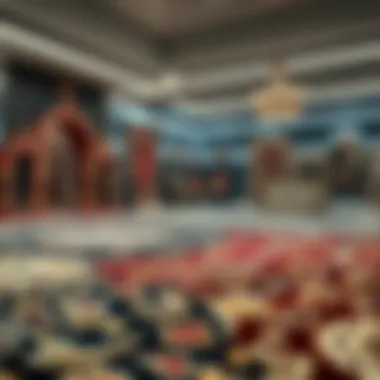
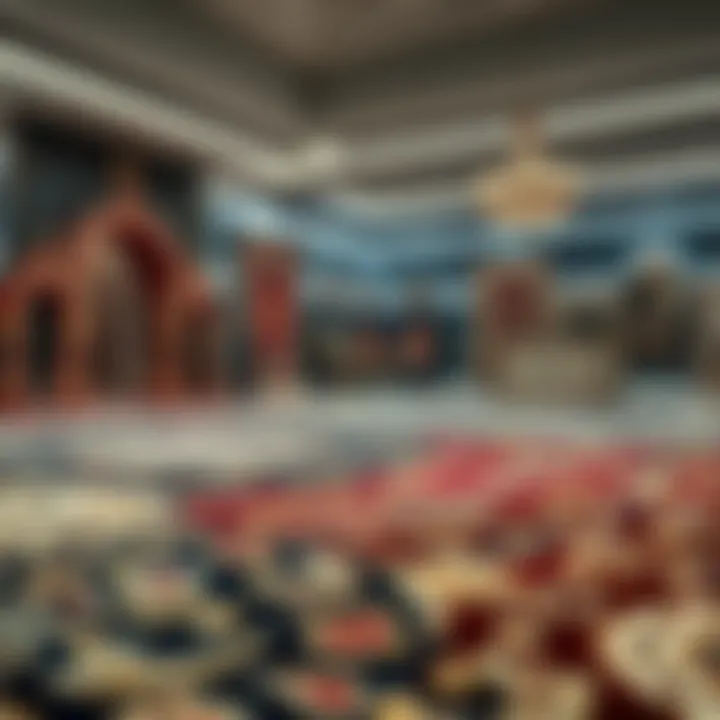
Intro
Exploring the world of carpets in Dubai is more than just a shopping endeavor; it’s an immersion into a tapestry of tradition, luxury, and artistry. Dubai, renowned for its opulence, offers a diverse selection of carpets that cater to various tastes and preferences. From the lush textures of Persian designs to the sleek lines of contemporary patterns, every carpet tells a story, often woven into the very fabric of the city’s cultural heritage.
When selecting a carpet in Dubai, buyers must navigate an intricate landscape shaped by market trends, lifestyle factors, and the ever-evolving craftsmanship. This comprehensive guide seeks to unravel the complexities of carpet selection, highlighting not only what can elevate a space aesthetically but also what embodies the lifestyle and values of the individuals who dwell within it.
As we embark on this journey, we’ll delve into essential aspects such as market trends that influence choices, insights into luxurious neighborhood spaces, and the significance of supporting local artisans. Understanding these components is key for investors, homeowners, and anyone else aiming to curate an enriching home environment.
Market Trends
Current Property Prices
In Dubai, an intriguing relationship exists between property prices and the luxury carpet market. With the city experiencing fluctuations in property values, the demand for elegant carpets often correlates. The flourishing real estate sector, especially in areas like Dubai Marina and Downtown Dubai, has increased the necessity for distinctive home decor. High-end carpets have become a crucial part of creating that desired opulent atmosphere.
Notably, as property prices rise, so does the expectation for quality furnishings. Homeowners are now seeking carpets that not only complement their living spaces but also signify their status. With diverse price ranges available, buyers can find stylish options without stretching their budgets too thin.
Future Market Projections
Forecasting the carpet market in Dubai involves looking at several indicators, including the overall economic climate and changing consumer preferences. Experts have noted a growing trend towards eco-friendly materials and practices, reflecting a global consciousness. The rise in popularity of sustainable carpets made from organic fibers will likely influence future offerings, aligning with the eco-responsibility that many buyers are now prioritizing.
Additionally, technological advancements in carpet manufacturing are set to alter the landscape. Interactive designs and smart carpets, equipped with features that contribute to comfort and ambience, could redefine consumer expectations. As investors and homeowners seek innovation, these shifts promise to create exciting prospects across the market.
“In Dubai’s dynamic market, quality and sustainability are becoming non-negotiables for discerning carpet buyers.”
Lifestyle Insights
Neighborhood Highlights
Dubai’s neighborhoods offer a canvas for understanding the rich diversity that informs carpet choices. Each area, from the traditional allure of Deira to the modern elegance of Jumeirah, has its own character that can inspire unique carpet selections.
For instance, in the vibrant souks of Deira, visitors find intricately designed carpets, showcasing the skilled handiwork of local artisans. Whereas affluent areas like Emirates Hills present a different story, where minimalistic, contemporary designs often dominate luxurious estates. Understanding the local flavor deeply enriches the carpet selection process and allows buyers to reflect personal style informed by their neighborhoods.
Community Amenities
The amenities available within a community play an important role in shaping lifestyle choices, including carpet selections. Access to local artisans, fabric markets, and high-end showrooms creates a vibrant tapestry of options. Buyers can enjoy personalized experiences, often with the opportunity to commission bespoke carpets that fit perfectly into their homes.
In many cases, community events centered on design and aesthetics nurture exchanges of ideas among buyers, which can spark inspiration when it comes to choosing the right carpet. Having these resources at hand amplifies the excitement of investing in a beautiful flooring statement that resonates with the local culture.
As we navigate deeper into the nuances of selecting carpets in Dubai, understanding the interplay between market dynamics, community choices, and personal taste will be essential for every discerning buyer. A well-chosen carpet is not just a piece of decoration; it embodies a lifestyle, a connection to the community, and an appreciation for craftsmanship.
Prelims to Carpets in Dubai
Carpets have woven themselves into the very fabric of Dubai’s culture and lifestyle, serving not only as practical essentials but also as significant cultural artifacts. In this bustling metropolis, where tradition meets modernity, carpets play a crucial role in both homes and businesses. This section aims to explore the essence of carpets in Dubai, bringing forth the unique aspects that make them an integral part of the local identity.
The rich history of carpet weaving in the region is often highlighted through its intricate patterns and vibrant colors. With influences from Persian, Turkish, and even contemporary designs, the local carpet market presents a fascinating tapestry of artistic expression. Understanding this cultural backdrop allows potential buyers, whether they are investors, homeowners, or simply enthusiasts, to appreciate the craftsmanship behind each piece.
Furthermore, carpets contribute significantly to the aesthetic value of a space. They are not just items of luxury but also serve practical purposes such as insulation against the desert chill and noise reduction in high-ceilinged residences or commercial venues. Consequently, selecting the right carpet can dramatically enhance both comfort and style in one’s living environment.
Key Considerations
- Cultural Significance: Carpets often symbolize the heritage and artistry of the region, reflecting stories of lineage and craftsmanship.
- Material Choices: The choice of fabric can impact durability, appearance, and maintenance, which is essential in a high-temperature climate.
- Aesthetic Compatibility: A well-chosen carpet can unify interior decor, creating a harmonious ambience in any room.
Market Overview for Carpets in Dubai
The carpet market in Dubai is a vibrant tapestry, intricately woven with history, cultural significance, and contemporary trends. Understanding this market is vitally important for anyone who aims to make informed choices in carpet selection, whether they are homeowners, investors, or interior designers. This section provides a comprehensive overview of the dynamics that govern carpet buying in Dubai, including historical context, current market trends, and key players influencing this booming industry.
Historical Context
Dubai's relationship with carpets is as rich as the patterns woven into them. For centuries, carpets have served not merely as decorative pieces but as symbols of wealth and status. The trade has roots that hark back to the early days of Dubai, when textiles were among the primary goods exchanged in the bustling emirate's souks. The historical significance is evident in how carpets have shaped local aesthetics, influencing architectural designs and interior layouts.
Over the decades, traditional styles have evolved, but many craftsmen still honor age-old techniques. In traditional Emirati culture, gifts of finely woven carpets often mark significant occasions like weddings or business partnerships, showcasing the fabric’s role as a cultural artifact. These themes set the stage for the modern market, where heritage meets innovation.
Current Trends
As of late, the carpet market in Dubai has been undergoing significant shifts influenced by globalization and changing consumer preferences. Sustainability is a trending topic, with many buyers leaning towards eco-friendly materials and manufacturing processes. Consumers are increasingly interested in carpets made from recycled fibers or organic materials, appealing to the environmentally conscious.
Another trend is the rise of customization. Modern buyers now seek carpets that reflect personal narratives or unique themes, leading to collaborations between designers and local artisans. Furthermore, the integration of technology, such as the use of 3D printing in carpet design, is also emerging, providing options that were unimaginable a few years ago. With these developments, both functionality and aesthetics have become critical to consumer choices.
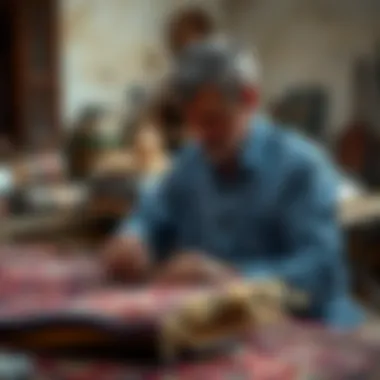
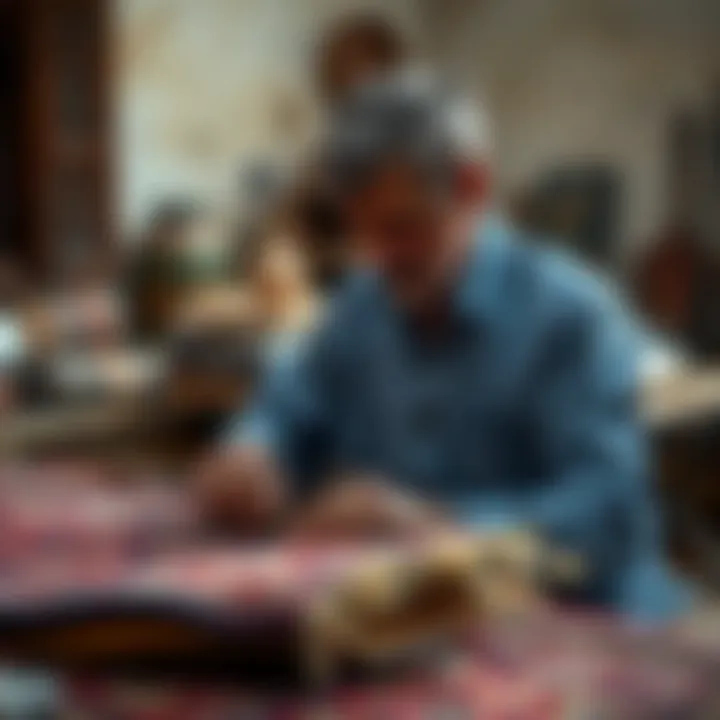
Key Players in the Market
The carpet market in Dubai is characterized by a melange of both local artisans and international brands. Key players include prestigious companies like Al Bait Almaal and Royal Persian Carpets, known for their exquisite selections of traditional and contemporary options. These businesses not only provide a variety of carpets but also emphasize quality and craftsmanship.
In addition to established companies, newer players tapping into the growing demand for sophisticated designs are also making a name for themselves. Smaller, boutique shops are emerging, capitalizing on the trend for bespoke and custom-made carpets. They often source materials ethically, which resonates with the modern Dubai consumer, who values transparency and quality.
The interplay between these traditional and contemporary forces creates a rich market landscape, ensuring that consumers in Dubai have access to a broad range of carpet choices that marry artistry with modern sensibility.
Types of Carpets Available
Understanding the various types of carpets available is crucial for anyone looking to make an informed decision in the vibrant marketplace of Dubai. With a rich history of craftsmanship and a blend of cultural influences, the options can be overwhelming. However, knowing the right type can add not only warmth but character to a home, reflecting a buyer's taste and lifestyle. Each type of carpet serves a specific purpose and offers unique benefits.
Persian Carpets
Often considered the epitome of luxury, Persian carpets add an air of sophistication to any space. These carpets are known for their intricate designs and high-quality materials, usually handwoven from wool or silk. One of the key attractions of Persian carpets is the variety in patterns and colors, ranging from the geometric simplicity to floral extravagance.
For buyers, investing in a Persian carpet means becoming part of a centuries-old tradition. Each piece tells a story, with designs reflecting the region of origin—whether it be Tabriz, Kashan, or Isfahan. The uniqueness of Persian carpets often comes at a price, hence it’s important to assess the craftsmanship, origin, and whether it has been ethically sourced.
Oriental Rugs
Oriental rugs are a broad category that encompasses a myriad of styles and cultural backgrounds, including Turkish, Chinese, and Indian influences. What sets them apart is their artistic patterns and cultural significance, which can vary widely from one region to another. The materials used, typically wool or silk, can range in quality significantly, offering options for various budgets.
When considering an Oriental rug, take note of the knot density, which indicates the quality and intricacy of the piece. Many enthusiasts appreciate these rugs for their handwoven nature and storytelling aspect. They often serve as conversation starters, highlighting rich cultural histories that make them desirable decorative elements.
Modern Carpets
The modern carpeting scene offers a refreshing twist, appealing to those with contemporary aesthetics. These carpets are designed using innovative techniques and often incorporate synthetic materials such as nylon or polyester, which can provide durability alongside style. Modern carpets can come in a variety of textures and colors, ensuring that they fit seamlessly into contemporary living spaces.
Their maintenance is generally more straightforward compared to traditional options, appealing especially to busy homeowners or renters. Many modern carpets also focus on eco-friendliness, thus attracting environmentally-conscious consumers. The diversity in design allows personal expression, catering to various preferences and needs.
Luxury Designer Brands
For those willing to splurge, luxury designer carpets represent the pinnacle of opulence. Brands like Rug Company, Sarraghi, and Christopher Farr offer bespoke solutions, allowing individuals to create something that is uniquely theirs. These carpets are often crafted manually, emphasizing high-quality materials and artisan techniques.
Luxury carpets not only elevate the ambiance of a room but also serve as a status symbol. When investing in such pieces, it's essential to consider factors like brand reputation, warranty, and exclusivity, as well as how the design complements existing decor. These distinctions often justify the investment, promising both aesthetic appeal and longevity.
"Selecting the right carpet goes beyond mere aesthetics; it’s about creating an atmosphere that resonates with your lifestyle."
In summary, selecting the appropriate type of carpet in Dubai involves understanding one's needs and preferences. Whether opting for a traditional Persian piece, an exotic Oriental rug, a modern option, or a luxurious design, the carpet will undoubtedly play a significant role in transforming living spaces.
Materials Used in Carpets
The materials used in carpets play a pivotal role in defining their quality, durability, and aesthetic appeal. Understanding these materials equips buyers with the knowledge to make informed decisions, ensuring that the chosen carpet aligns with their specific needs, style preferences, and the practical requirements of their living space. Each material carries its own unique characteristics, advantages, and drawbacks that can significantly influence the overall impact of a carpet in a home or commercial setting.
Wool Carpets
Wool has long stood as the gold standard in carpet materials. Its natural fibers are not only soft to the touch but also exhibit impressive resilience. Wool carpets are known for their durability, and they hold dye well, producing vibrant colors and intricate patterns. Additionally, wool has natural insulating properties, which can help maintain comfortable temperatures in a room regardless of external weather.
Maintenance, while necessary, can be relatively straightforward. Regular vacuuming and occasional professional cleaning are usually sufficient to preserve their beauty without much hassle. One might find the price point on the higher end, but investing in a quality wool carpet can pay dividends over time, as they often outlast many synthetic options.
Silk Carpets
Silk carpets are the epitome of luxury. These carpets dazzle with their radiant sheen and luminous colors. The delicacy of silk brings a touch of elegance to any setting, making them particularly favored for formal spaces. The soft texture is a delight underfoot, promoting an atmosphere of opulence.
However, silk requires careful handling and maintenance. They're typically less durable than their wool counterparts, and exposure to heavy foot traffic or moisture can lead to damage. Hence, they may not be the best choice for every household. It's best to place silk carpets in areas where they can truly shine without the risk of wear and tear.
Synthetic Fibers
The advent of synthetic fibers has revolutionized the carpet industry, offering affordability without sacrificing style. Materials such as nylon and polyester are known for their exceptional stain resistance and durability. These carpets are perfect for families with children or pets, where spills are an everyday occurrence.
Moreover, manufacturers often create synthetic carpets that mimic the look and feel of natural fibers, providing the best of both worlds. While they may not have the same lifespan as wool or silk, they do offer a cost-effective solution for those looking to refresh their space without extensive investment.
Eco-Friendly Options
In recent years, the demand for sustainability has surged, paving the way for eco-friendly carpet options. Materials like jute, sisal, and recycled fibers are becoming more prominent in the market. These carpets not only alleviate the environmental burden but often bring a unique aesthetic to a space.
Homeowners can enjoy peace of mind knowing their choices contribute to a greener planet. Plus, many eco-friendly carpets boast durability comparable to traditional options. When considering a carpet purchase, environmentally conscious buyers will find no shortage of impressive styles that also reflect their values.
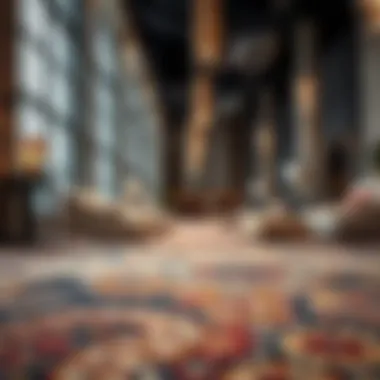
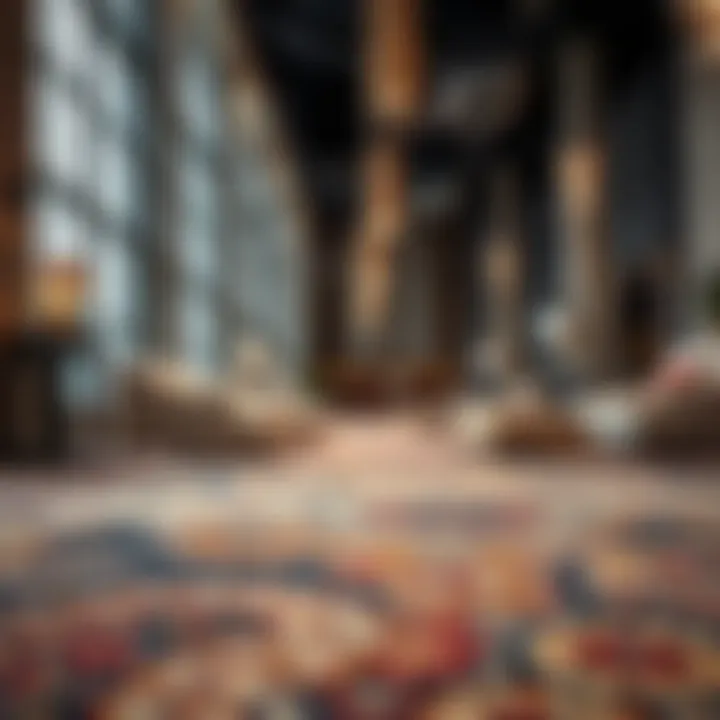
"Choosing the right carpet material is like selecting an outfit. It must cater to both appearance and functionality."
Cultural Significance of Carpets
In Dubai, carpets are not just about aesthetics; they hold a deep cultural resonance that extends through history. They serve as a symbol of wealth and status, encapsulating the rich tapestry of traditions that the region values. Understanding their cultural significance sheds light on why carpets are often considered treasures rather than mere decorative items.
The artistry found in carpets speaks volumes about the heritage of the people who weave them. Each design, color, and pattern can reflect stories and beliefs that have been passed down through generations. It's common to see intricate motifs that draw from local folklore, historical events, or spiritual symbols. Owning a carpet is akin to owning a piece of art that carries both a visual appeal and a narrative depth.
“A carpet not only adorns the floor but also elevates the spirit of a home.”
When you walk through spaces adorned with carpets, you’re stepping onto a canvas of diverse cultural expressions. The material itself also plays a role, as the choice of fibers and colors can signify different social classes or regions in the UAE. For instance, vibrant colors may speak to more prosperous lifestyles, whereas subtle tones might be reflective of more traditional values.
Moreover, the craftsmanship involved in local carpet making has immense cultural weight. Many artisans, often generational weavers, pass down their skills and techniques, ensuring that the traditions stay alive. This artisan approach is increasingly recognized and celebrated, making every piece a testament to the dedication and hard work of these craftsmen. The production of carpets is often a communal effort, bringing families and neighborhoods together, fostering a sense of unity and shared heritage.
Symbolism in Design
The designs found in carpets can often be deciphered like a language. Each pattern carries its own symbolism, and discerning individuals can read deeply into the carpets' meanings. For instance, geometric patterns might represent harmony and balance, while floral motifs are associated with prosperity and abundance.
When selecting a carpet, understanding these symbolic elements can be pivotal. A homeowner might choose a carpet adorned with specific designs that reflect their personal values or aspirations. Similarly, businesses might display carpets that symbolize success and welcome, aiming to create a positive impression on clients.
These symbols extend beyond aesthetics; they often communicate the values and beliefs of the community. That makes the act of carpet buying not just about choosing a beautiful piece but also about making a statement regarding one’s identity and values.
Ceremonial Uses
Carpets are more than just decor in Dubai; they play a vital role in various ceremonies and celebrations. From weddings to religious gatherings, carpets are woven into the fabric of important life events. During weddings, for instance, specially designed carpets might be laid out for the bride and groom, symbolizing their new journey together.
In religious contexts, carpets often serve as sacred spaces for prayers, accentuating their importance and reverence. Their presence in mosques reinforces the notion of sanctity, offering a space of comfort and reflection for worshippers.
Additionally, carpets might also be utilized in cultural celebrations, adding an authentic touch to communal gatherings. They embody the spirit of hospitality that is prominent in Emirati culture, where inviting guests to sit on a beautifully adorned carpet speaks volumes about the host’s respect and regard.
Local Craftsmanship and Artisanship
In the vast landscape of Dubai's carpet industry, local craftsmanship and artisanship hold a paramount position. The intricate tapestries crafted in this city don't merely serve as decorative items but as reflections of the rich heritage and skills passed down through generations. This aspect of artistry serves not just to elevate the aesthetic of a space but to narrate the stories of cultural legacies that define Dubai.
One of the key elements to appreciate is the attention to detail and dedication that goes into each piece. Artisans, often trained from a young age, immerse themselves in the rich history of their craft. They don't just weave carpets; they weave history, employing techniques learned from their forebears. The craftsmanship entails a deep understanding of the materials involved, the methods of weaving, and the symbolic significance of designs. Whether it’s a classic Persian pattern or a more contemporary geometric layout, each design choice carries meaning.
Traditional Weaving Techniques
The essence of traditional weaving techniques is truly fascinating. The most celebrated methods involve hand-knotting, where artisans create floor coverings with incredible precision. Methods like this date back hundreds of years and have adapted over time, blending influence from various cultures.
- Hand-Knotting: This technique involves manually tying each knot, ensuring durability and unparalleled artistic expression. A rug created with this method often takes months to complete, reflecting both the skill of the artisan and the spirit of patience.
- Flat-Weaving: Preferred for creating lighter carpets, this technique does away with the pile, making the resulting pieces easy to maintain. It’s especially popular for smaller sizes and decorative items.
The mastery of these practices not only preserves authenticity but also provides a unique character to carpets. A hand-made carpet has a soul; each imperfection tells tales of the hands that crafted it.
Contemporary Innovations
As the landscape of carpet production evolves, contemporary innovations are paving new avenues for artisans while remaining rooted in tradition. Dubai has embraced technology selectively, introducing advanced machinery while still respecting age-old practices.
- Digital Designs: Nowadays, many artisans are using computer-generated designs to map out patterns, allowing for precise replication and experimentation. This has made luxury carpets more accessible, albeit with a new layer of complexity in artistry.
- Sustainable Practices: There is also a significant shift toward eco-friendly materials and processes. Artisans are experimenting with organic dyes and natural fibers, ensuring that the creation process is as harmonious with the environment as it is with cultural heritage.
- Hybrid Techniques: Some craftsmen combine traditional methods with modern techniques, leading to unique products that embrace both worlds. For instance, a contemporary rug might feature traditional motifs while employing synthetic fibers for enhanced durability and ease of care.
The combination of local craftsmanship and contemporary innovations not only feeds the demand for exquisite carpets but also positions Dubai as a leader in global craftsmanship, attracting attention from investors, homeowners, and designers eager to incorporate these bespoke pieces into their environments.
"In every thread woven by these artisans lies a story enriched with culture, dedication, and innovation—a testament to their craft."
To truly appreciate the beauty behind each carpet, one must look past the surface and see the tales imbued in every fiber.
Buying Guide for Carpets in Dubai
When it comes to selecting carpets in Dubai, a well-informed approach can make all the difference. The city's vibrant culture and the diverse styles available can be overwhelming. This buying guide aims to simplify the selection process by highlighting crucial factors to consider and where to find the ideal carpet for your home or office.
Factors to Consider
Selecting a carpet isn't just about picking a pretty design. There are several elements worth your attention:
- Purpose of the Carpet: Determine if the carpet is for a high-traffic area, a serene bedroom, or perhaps an aesthetic piece for your living room. Each area may require different durability.
- Material Selection: Different materials offer unique benefits. For example, wool carpets are celebrated for warmth and resilience, while silk offers a touch of luxury. Synthetic fibers, on the other hand, are often easier to maintain. Think about how each material complements your lifestyle.
- Size and Fit: Before you delve into carpet shopping, measure the area precisely. Having the dimensions ready can save you from purchasing a carpet that doesn't fit. A large carpet can enhance a room’s spacious feel, while smaller ones can define spaces in open layouts.
- Design and Color Scheme: Ensure that the carpet's design harmonizes with the overall aesthetic of your space. Consider the existing color palette, and don’t shy away from bold patterns if they resonate with your style. Remember, the flooring anchors the room’s design.
- Budget Considerations: Carpets can range widely in price according to material, design, and brand. Set a realistic budget that allows flexibility for quality while keeping your financial goals in check.
"Quality carpets are an investment, not just a purchase. It’s essential to spend wisely."
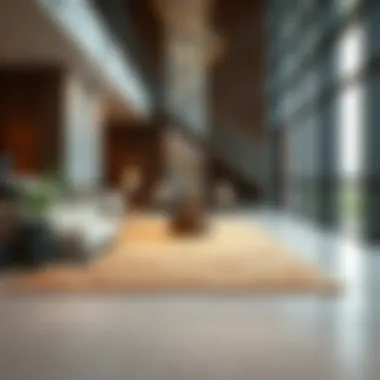
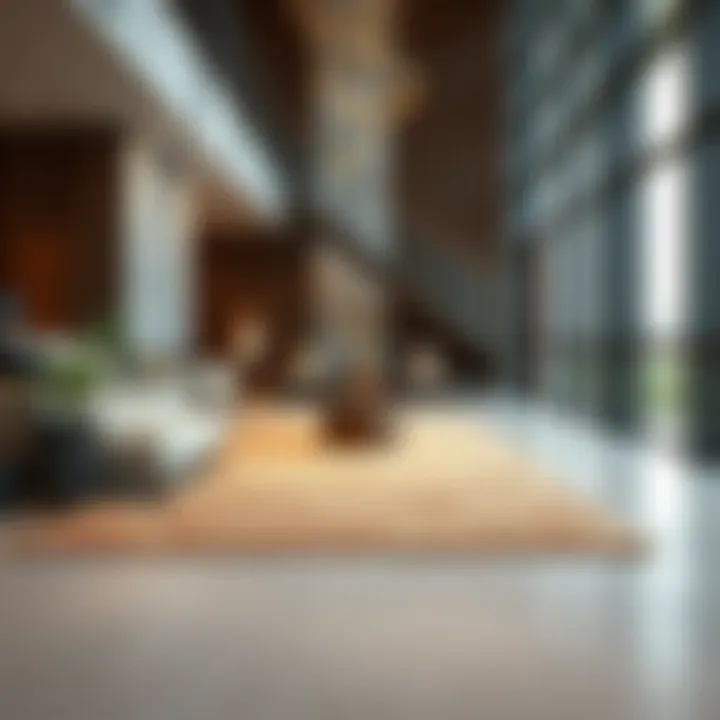
Where to Purchase
Dubai offers an array of options for carpet shopping, from local artisans to high-end retailers. Here are some respected places to consider:
- Meena Bazaar: This bustling market is known for its variety of carpets, from traditional Persian designs to modern options. A stroll through the narrow lanes can lead to hidden gems.
- Dubai Mall: For a luxury carpet experience, check out the specialized stores within this iconic shopping center. Here, you can find renowned designer brands like Armani Casa and Mozaic, where quality meets style.
- Al Quoz: This area is home to several art and design showrooms offering custom carpet solutions. It’s worth visiting if you're after something unique, tailored specifically to your preference.
- Online Platforms: E-commerce has gained traction, allowing you to browse a variety of options from the comfort of home. Websites like CarpetSouk.com and Souk.com can be useful when searching for competitive prices and exclusive designs. However, ensure that you understand the return policies, as seeing a carpet in person is often different than viewing it online.
Diving into the carpet market in Dubai can be an exciting journey. With these insights, you can confidently navigate through your options, keeping in mind factors that resonate with your personal taste and lifestyle.
Maintenance and Care of Carpets
Taking good care of carpets is essential, especially in a vibrant city like Dubai where style and luxury go hand in hand. Carpets are not just decorative items; they are an investment in your home that requires attention to maintain their beauty and longevity. Neglecting proper care can lead to premature wear and tear, disappointing the expectations of luxury associated with fine carpets.
One of the key reasons for prioritizing carpet maintenance is the aesthetic appeal. Regular cleaning and upkeep ensure that your carpets retain their vibrant colors and intricate designs, adding to the overall ambience of your space. Furthermore, a well-maintained carpet can improve indoor air quality, reducing allergens and dust that tend to accumulate in fibers. The bottom line is that a clean carpet enhances your living environment and can even prolong the life of your investment.
Cleaning Tips
Keeping carpets in tip-top shape isn't just about the occasional vacuum. Here are some healthy habits to incorporate into your carpet care routine:
- Vacuum Regularly: A vacuum may seem like an oldie, but it's your first line of defense against dirt and grime. Aim for at least once a week, and more often in high-traffic areas.
- Spot Clean Immediately: Accidents happen, whether it's a spilled drink or a muddy shoe. Address spills quickly by blotting with a clean cloth. Never rub; this can damage the fibers. For those pesky stains, consider using a solution that is suitable for your carpet type, such as a gentle detergent or a vinegar-water mixture.
- Deep Clean Periodically: Every year, give your carpet a thorough cleaning. Depending on the type of carpet you have, hiring professionals may yield the best results. They have access to equipment and cleaning solutions that can bring your carpets back to their glory days.
Incorporating these practices into your cleaning routine can yield significant benefits over time. A clean carpet is more inviting and reduces the wear on the fibers.
Preventative Measures
Prevention is significantly better than cure when it comes to carpet maintenance. Simple steps taken upfront can save a lot of headaches later on:
- Use Area Rugs: Placing area rugs in the most utilized spots can minimize wear. They act as a shield while still complementing your broader decor.
- Implement a No-Shoe Policy: Encourage family and guests to remove their shoes before walking on carpets. This simple rule drastically cuts down dirt and debris that finds its way into the fibers.
- Choose Carpet Pad Wisely: The right padding can make all the difference in how well your carpet lasts. A quality pad not only extends the life of your carpet but also makes it more comfortable underfoot.
- Routine Inspection: Regularly check your carpets for any signs of wear or damage. Catching problems early can help avoid them from escalating into more significant issues.
By adopting these preventative strategies, you can protect your investment and keep your carpets looking pristine for years to come.
"A stitch in time saves nine," they say. Staying proactive in carpet care ensures lasting beauty and performance in your living space.
For further reading on carpet maintenance, you might find insights from Wikipedia on Carpets helpful.
Future Trends in Carpet Design
The realm of carpet design is undergoing a transformation driven by a confluence of cultural influences, technological advancements, and a deepening awareness of sustainability. Understanding these future trends is crucial for anyone looking to invest in carpets, whether for personal spaces or commercial applications. Recognizing these shifts can help buyers choose carpets that not only enhance their aesthetic but also align with the evolving preferences of the market.
Sustainable Practices
Sustainability has become a watchword in the carpet industry, reflecting the growing environmental conscience among consumers. More individuals are opting for carpets that leave a lighter carbon footprint. Carpets made from natural fibers such as jute, sisal, and wool are gaining traction, as they are biodegradable and renewable. This shift not only contributes to environmental preservation but also aligns with a growing demand for healthier living spaces.
Furthermore, many manufacturers are working on upcycling materials, turning discarded textiles and plastics into beautiful carpets. This practice not only reduces waste but also encourages a culture of recycling within the industry. Buyers are increasingly keen on products that tell a story, where sustainability is intertwined with the essence of craftsmanship.
One aspect to consider is the ** certifications** attached to these carpets. When looking for sustainable options, buyers should seek labels like the Global Organic Textile Standard (GOTS) or the Clean Air Certification, which assure them of the product’s ecological and health credentials.
"Sustainability isn't just a trend, it's an integral part of the future of carpet design, reflecting our values in every fiber."
Technological Advancements
Advancements in technology are reshaping how carpets are designed, manufactured, and sold. Machine learning and AI are starting to play roles in predicting design trends and consumer preferences based on data analytics. For example, companies are now using AI to analyze buying patterns, leading to quicker adaptations in product lines that cater to shifting tastes.
Moreover, innovations in manufacturing processes have enabled improved quality control and customization options. Techniques like digital printing allow for intricate designs that were once labor-intensive to produce. Consumers can now request bespoke designs that fit their specific tastes, creating a personalized touch to their spaces.
Additionally, smart carpets are making their appearance, incorporating features that monitor environmental conditions within a home, like air quality and temperature. This intersection of technology and aesthetic value not only provides practical benefits but adds a novel aspect to the traditional carpet experience.
Closure
In closing, understanding the intricacies of the carpet market in Dubai is essential for making informed decisions, whether you're a homeowner aiming to elevate your space or an investor looking to tap into the luxurious home decor market. The insights provided throughout this guide illuminate the many facets of carpets, each holding a piece of Dubai's cultural tapestry.
A carpet is not just a decorative piece; it’s an investment that reflects both personal style and cultural heritage. With a wide array of materials available—from the luxuries of silk to the warmth of wool and the more sustainable synthetic options—consumers have the flexibility to choose according to their preferences and lifestyles. Buyers must consider factors such as durability, maintenance, and aesthetic appeal, allowing them to select carpets that are not only beautiful but practical.
The local craftsmanship in Dubai stands out as a beacon of artistry. Traditional weaving techniques combined with modern innovations showcase how carpets can be both timeless and trendy. Supporting local artisans is not just about purchasing a product; it's about investing in the community and preserving cultural methods that have flourished for generations.
Additionally, staying attuned to future trends lays the groundwork for foresight. With developments in sustainable practices and technology, the carpet industry in Dubai is poised for a significant evolution, transforming how we perceive and utilize carpets in our everyday lives.
Ultimately, this guide is not just about buying carpets; it's about understanding the emotional connection to home, art, and culture. As you step forward in this journey—whether it’s transforming your living room or enhancing a rental property—consider the value of the carpets you bring into your spaces. A well-chosen carpet can resonate with the essence of Dubai’s vibrant lifestyle, becoming a conversation starter and a source of pride for years to come.
"Investing in a carpet is investing in a story that unfolds beneath your feet, narrating both comfort and elegance."
For more detailed insights, consider visiting sites such as Wikipedia for historical context or Britannica for academic knowledge. Join discussions on platforms like Reddit to learn from real experiences, or consult local marketplaces for firsthand product evaluations.
By empowering yourself with the right information, you can confidently navigate the heart of Dubai's carpet offerings, ensuring that your selection truly reflects your unique tastes and the rich ambience of this remarkable city.











